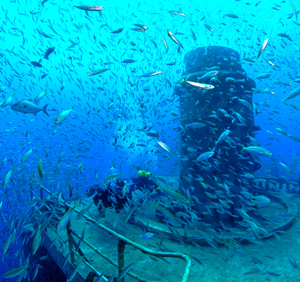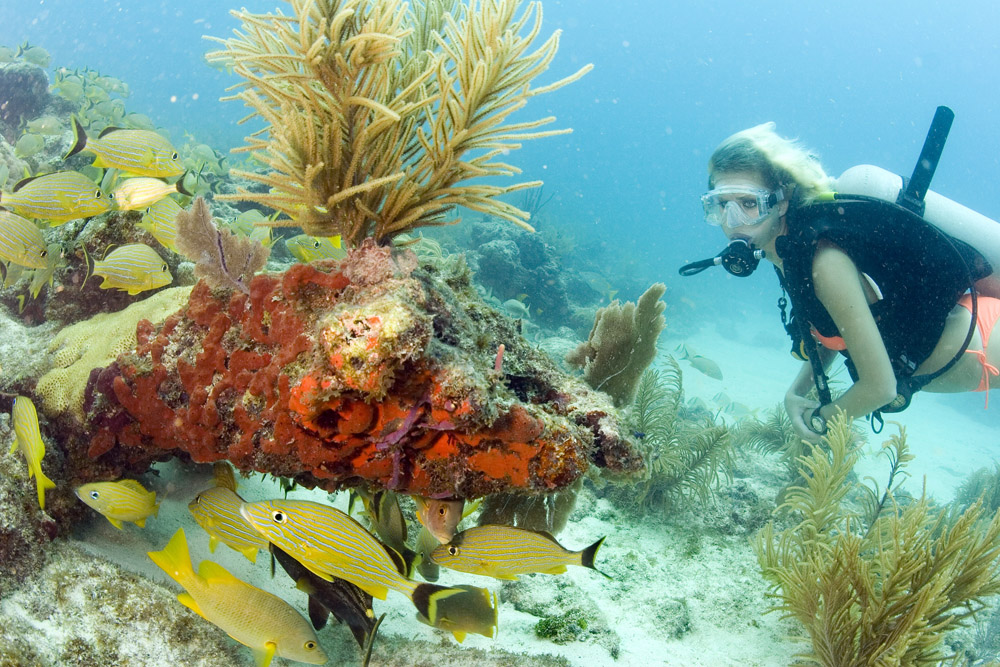Encouraging environmentally responsible behavior is a crucial element of the Florida Keys’ commitment to protecting the region’s natural resources.

Divers swim over the Vandenberg amid thousands of fish just a year after the vessel was sunk off Key West in the Florida Keys National Marine Sanctuary. (Photo by Don Kincaid, Florida Keys News Bureau)
The Florida Keys are home to the continental United States’ only living coral barrier reef. The island chain also has an array of artificial reefs that provide alternative structures for scuba divers to explore — and additional habitats for marine life.
Structures used to create artificial reefs, like the massive ship Gen. Hoyt S. Vandenberg that was intentionally sunk in the Florida Keys National Marine Sanctuary just over 10 years ago, attract enormous amounts of marine life.
Properly prepared shipwrecks like the Vandenberg provide a platform for education and research. They also preserve the history and heritage of the vessel.
Invertebrates and plants have attached to and colonized the Vandenberg wreck. Mobile invertebrates and reef fish are growing the food chain in and around the wreck, providing an ideal feeding and breeding environment as well as a haven from water currents.
Late spring and summer are the best times to explore the undersea world of the Florida Keys, but it’s important to practice some reef etiquette.
Before you hit the water, apply environmentally safe sunscreens to avoid introducing harmful chemicals (like oxybenzone) into the water that can poison corals.
Avoid contact with the ocean bottom, and be sure you practice properly weighted buoyancy control. Sandy areas that appear barren may support new growth if they’re left undisturbed.
 If you dive or snorkel on your own, use the reef mooring buoys instead of dropping an anchor. Many dive and snorkel sites are located within the Florida Keys National Marine Sanctuary, and anchoring in these Sanctuary Preservation Areas is forbidden.
If you dive or snorkel on your own, use the reef mooring buoys instead of dropping an anchor. Many dive and snorkel sites are located within the Florida Keys National Marine Sanctuary, and anchoring in these Sanctuary Preservation Areas is forbidden.
Protection of this truly unique natural system is essential for enjoyment today and for the benefit of future generations. Not everyone knows how sensitive corals are to being touched, anchor damage and sunscreen.
That’s why the Nature Conservancy is asking anglers and divers who treasure Florida’s reef to respect it, preserve and protect it, and help spread the word about seven tips in its recently launched #RespectOurReef campaign.
Tips include anchoring well away from coral heads; avoiding touching corals on a reef; using nontoxic sunscreen; not leaving unwanted fishing line on docks or in the water; and taking a pledge to protect the environment — and sharing that intention with social media buddies who also dive, snorkel, fish or enjoy the water.

People who dive or snorkel from their own boats should use reef mooring buoys instead of dropping an anchor. Anchoring is forbidden at many dive and snorkel sites.
Even visitors who aren’t active on or in the water can still enjoy the underwater world in the Florida Keys.
At the comprehensive new Coral Reef Exploration exhibit at the Florida Keys History & Discovery Center in Islamorada, underwater enthusiasts of all ages can explore three aquariums, educational storyboards, interactive kiosks and video monitors focused on providing a beautiful and educational view of the Keys’ unique coral reef ecosystem and the challenges it faces.
A 1,250-gallon aquarium showcases native local species, such as angel and butterfly fish, tangs and wrasse — plus invertebrates that make their home on and around Keys coral reefs. And two 280-gallon aquariums feature invasive lionfish, live corals, crustaceans and reef fish.
Interested in learning more about the Florida Keys’ water-and-land ecosystem, and positive steps you can take to protect it? Just click here.

